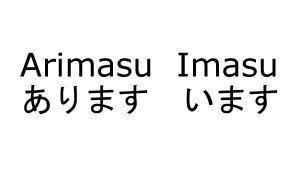Today we are going to learn a little about two verbs in the Japanese language, the Arimasu and Imasu.
I also leave the video below with the explanation plus all the transcribed content in a way that you can read and understand.
The video was made by Sarah from the channel faleemjap0nes which shows how simple it is to learn when to use these verbs.
I'll also take the opportunity to increment with more indications and relevant content.
So let's go to the video:
Arimasu and Imasu verbs – ???? – ???
So Arimasu and Imasu if you don't know that you can't speak practically any basic phrases in Japanese
Arimasu and Imasu mean to exist and to have, these verbs would be the English there is and there are.

There is an animal there or there is an animal and things like that.
But we won't have a difference like in English for singular and plural. The only difference we will have is that:
Arimasu is to be non-living/non-living beings
And Imasu is for living beings, with one exception HANA (??) of Flower, Tree and these things are not a living being in this case, so we won't say HANAGAIMASU but HANAGAARIMASU.
Let's give some examples to assemble the sentences, we will obviously need the particles, if you don't know about the particles watch the video below explaining all but NO (?).
More articles on particles:
Basic particles? Part 1 (? and ?)
Basic particles? Part 2 (? and ?)
The NO (?) particle is used when you want to leave a possession, so for example:
My name
WA TA SHI NO NA MA E
? ? ? ? ? ? ?
So in the beginning comes the person or thing to whom it belongs, then NO and then MONO (??) the thing
So in the case
WATASHI = person
NO NAMAE = namae then thing, so would be my name.
And so on, for example:
A NA TA NO KO N PYU U TA A
???????????
your computer
ANATA = you
With NO = your
KONPYUTAA = computer
You have to remember that:
ARIMASU is for non-living beings and also flowers, trees and such things
And IMASU for living beings, for example:
HI TO GA I MASU
??????
HITO = person
Ga = private
IMASU = exists/has
So HITOGAIMASU has a person/there is a person.
As a person is a living being and we will not use ARIMASU, but IMASU, another example is:
TSUKU AND GA A RIMASU
????????
TSUKU E?table/things being non-living
GA = particle
ARIMASU have/exist
So since TSUKU E is a non-living thing, we will use ARIMASU and not IMASU
TSUKUEGAARIMASU = there is a table/There is a table
One more example of each, so let's make it a little longer now since we know more particles.
IE NI WA HO N GA A RIMASU
???????????
IE = house
NIWA = na
HON = book
GA = particle
ARIMASU = have/exist
IENIWAHONGAARIMASU
there is a book in the house
Now if you want to leave it, there is a book in my house;
WA TASHINO IE NI WAHO N GA A RIMASU
???????????????
And now if I want to change HON (??) from the book to dog we'll have to change the verb too, it won't be ARIMASU anymore because it's going to be a living being now, it's going to be IMASU, so:
WA TASHI NO IE NI WA I NUGA IMASU
??????????????
WATASHINO = my
IE = house
NIWA = na
INU = dog
GA = particle
IMASU = exists/has
That is, there is a dog in my house
I hope you have understood the difference between ARIMASU and IMASU once again; living being IMASU taking flowers, trees and such things, non-living being ARIMASU, OK?
To make it clearer in the NHK course there is an explanation about this difference and exception of the flower, tree, etc.:
When talking about inanimate things, ARIMASU is used. Something is defined as animate or inanimate depending not only on whether it has life but also whether it is able to move around on its own.
Plants, for example, have life but cannot move. Therefore, ARIMASU is used for them. Fish sold in a market cannot move. Therefore, ARIMASU is used when referring to them. However, if it is a fish swimming in an aquarium, it should be said IMASU.
Buses and cars do not move alone. However, if they are being driven by drivers, IMASU is used.
Source: NHK course
Negative form
When you want to say that such a thing or being is not there, you change the MASU to MASEN, thus:
| Affirmative form | Negative form |
|---|---|
| IMASU | IMASEN |
| ARIMASU | ARIMASEN |
An example sentence found in Lesson 10 of the NHK course:
ANNA-SAN GA IMASEN.
???????????
Anna is not here.
In order not to lose focus, let's leave the Informal form in the present and past, past negative, past present of these verbs for another article.
I hope you enjoyed it and don't forget to leave your comment!
Ganbatte!